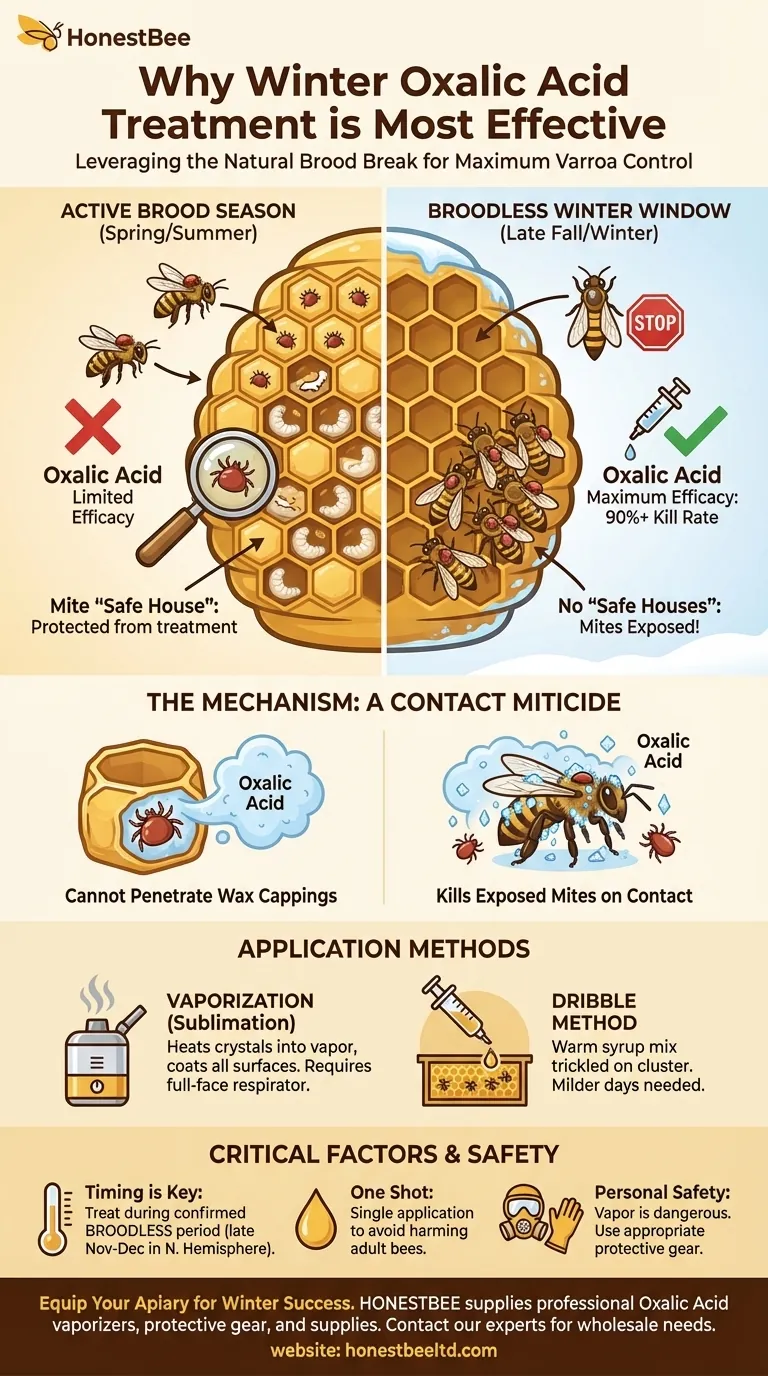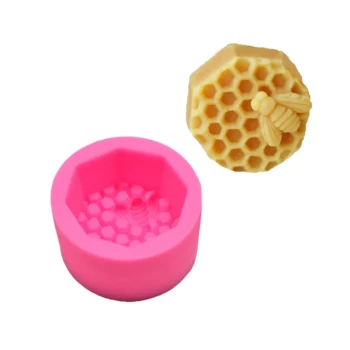Winter oxalic acid treatment is effective primarily because of one key factor: the absence of honey bee brood. During the cold months, the queen bee naturally stops or significantly slows her egg-laying. This forces the parasitic Varroa mites out of their protected reproductive sites within capped brood cells and onto the bodies of adult bees, making them vulnerable to treatment.
The core challenge in managing Varroa mites is that they spend much of their life cycle hidden and protected within sealed brood cells. Oxalic acid's high effectiveness in winter stems from its application during a natural "brood break," when nearly the entire mite population is exposed and can be eliminated in a single, well-timed treatment.

The Varroa Mite Life Cycle: The Root of the Problem
To understand why winter treatment is so effective, you must first understand the enemy. The Varroa destructor mite's life cycle is perfectly synchronized with the honey bee colony, which is what makes it so resilient.
The Two Phases of a Mite's Life
A mite's life is split into two distinct phases. The first is the phoretic phase, where the mite rides on an adult honey bee, feeding on its fat bodies.
The second is the reproductive phase. For this, the female mite enters a brood cell just before it is capped. She then lays her eggs, which hatch, mate, and develop alongside the bee pupa.
Why Brood Cells Are a Mite "Safe House"
Once a brood cell is capped with wax, the mites inside are completely shielded. They are safe from grooming bees and, critically, from nearly all chemical treatments beekeepers use, including oxalic acid.
A hive with a large amount of brood is a hive with a large, protected reservoir of mites.
The Natural Winter Brood Break
In colder climates, the queen bee ceases laying eggs in late fall or early winter to conserve colony resources. This creates a period known as a brood break, which can last for several weeks or even months.
During this time, the entire mite population is forced into the phoretic phase. There are no "safe houses" left. Every mite in the hive is attached to an adult bee, out in the open.
How Oxalic Acid Works
Oxalic acid is a naturally occurring organic compound found in many plants, including spinach and rhubarb. In beekeeping, it is used as a "soft" chemical treatment for Varroa mites.
A Contact-Only Miticide
Oxalic acid is a contact miticide. It only kills the mites that it physically touches. It has no ability to penetrate the wax cappings of brood cells.
This is the most critical concept to grasp. If you treat a colony that has capped brood, you will kill the phoretic mites, but you will leave the much larger reproductive mite population completely untouched. They will simply emerge later and re-infest the colony.
The "Broodless" Window of Opportunity
The winter brood break creates the perfect window for an oxalic acid treatment. When there is no brood, all mites are exposed.
A single application of oxalic acid during this period can kill over 90% of the mites in a hive. This dramatically reduces the mite load, allowing the colony to build up healthy and strong in the spring.
Application Methods: Vaporization vs. Dribble
There are two primary methods for applying oxalic acid.
Vaporization (or Sublimation) involves heating oxalic acid crystals in a special device. This turns the crystals directly into a vapor that fills the hive, coating all surfaces and bees, and killing the mites on contact.
Dribbling involves mixing oxalic acid with a warm sugar syrup and trickling a set amount directly onto the bees between the frames. The bees' movement then spreads the solution throughout the cluster.
Understanding the Trade-offs and Risks
While highly effective, oxalic acid treatment is not without risks and requires precise execution.
The Critical Importance of Timing
Timing is everything. Treating too early in the fall, when significant brood is still present, will result in a poor kill rate and wasted effort.
Conversely, treating in the absolute depths of winter on a very cold day can be overly stressful for the bees, especially if you must open the hive to perform a dribble treatment.
The Dangers of Over-Treatment
Oxalic acid is an acid, and it can be harmful to bees if used improperly. The approved treatment is a single application during a broodless period.
Repeated applications can harm open brood (if present) and can be corrosive to the adult bees' bodies, potentially shortening their lifespan. It should never be used when honey supers intended for human consumption are on the hive.
Personal Safety is Non-Negotiable
Oxalic acid vapor is extremely dangerous to the human respiratory system, and the crystals can damage skin and eyes.
When vaporizing, you must wear a full-face respirator with appropriate acid gas cartridges, along with safety goggles and gloves. Be mindful of wind direction to protect yourself and others.
Timing Your Winter Treatment for Maximum Impact
Success depends on applying the treatment when your specific colony is broodless. This timing can vary based on your local climate and the genetics of your bees.
- If your primary focus is maximum efficacy: Perform a single oxalic acid vaporization treatment after several weeks of consistently cold weather, typically in late November through late December (in the Northern Hemisphere), when you are confident the hive is broodless.
- If you are unsure about the brood status: On a mild winter day (above 45°F / 7°C), you can perform a quick inspection by pulling a single frame from the center of the cluster to look for capped brood before you treat.
- If you choose the dribble method: Apply this on a milder winter day to avoid chilling the bees with the cool syrup, as this can cause undue stress to the winter cluster.
By aligning your treatment with the bees' natural winter cycle, you can achieve highly effective Varroa control with minimal intervention.
Summary Table:
| Key Factor | Why It Matters for Oxalic Acid Treatment |
|---|---|
| Brood Break | Queen stops laying eggs, forcing all mites onto adult bees and out of protected brood cells. |
| Contact Miticide | Oxalic Acid only kills mites it touches; it cannot penetrate sealed brood cells. |
| High Efficacy | A single winter application can eliminate over 90% of the mite population. |
| Critical Timing | Treatment must be applied during the confirmed broodless period for maximum impact. |
Ensure your commercial apiary or distribution business is equipped for effective winter mite control. HONESTBEE supplies beekeepers and beekeeping equipment distributors with the professional-grade Oxalic Acid vaporizers, protective gear, and application supplies needed for safe, successful treatments. Protect your colonies and your investment—contact our experts today to discuss your wholesale needs and build a stronger, healthier operation for the season ahead.
Visual Guide

Related Products
- Heavy Duty 12V Oxalic Acid Evaporator Vaporizer for Bee Varroa Mite Treatment Beekeeping Fumigator Atomizer
- Wholesales Dadant Size Wooden Bee Hives for Beekeeping
- Langstroth Bee Hives Bee Keeping Box for Beginners Beekeeping
- Honey Flow Garden Bee Hive Flow Hive Best Beehive for Beginners
- Long Langstroth Style Horizontal Top Bar Hive for Wholesale
People Also Ask
- What are the methods for applying oxalic acid in beekeeping? Control Varroa Mites Effectively
- Why is oxalic acid not used in summer? Timing is critical for effective Varroa mite control.
- What is one of the more popular treatments for Varroa mites in recent years? Discover Oxalic Acid for Effective IPM
- What is the role of oxalic acid in plants? A Key to Plant Defense and Internal Regulation
- What safety precautions should be taken when using oxalic acid for vaporization? Protect Yourself and Your Bees



















